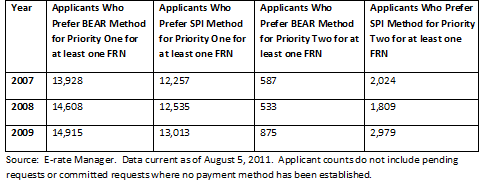Does this sound familiar? A well known politician once wrote that it “takes a village to raise a family” and in one sense, while not debating the merits of those remarks, the same principle applies to the E-rate invoicing process. It takes applicants, service providers and the SLD working together to ensure a smooth process.
There are two payment options that applicants can choose. Applicants can either pay their service provider 100% of the service/project in advance and get reimbursed (Form 472: BEAR) or they can request discounted invoices and it is up to the service provider to invoice (Form 474: SPIS) the SLD for the remaining amount.
There are obligations and responsibilities on all sides, regardless of what payment method is preferred. Here are a few ways that working together you can minimize delays and denials:
- Each year service providers need to file the Form 473, which is their annual certification form. If this form has not been filed, the SLD will not process a BEAR or SPI. As a best practice, the July timeframe is a good time for service providers to complete the SPAC.
- Each year, many applicants take months to file their Form 486 , causing payment delays and millions of dollars of commitment reductions. Neither the applicant nor the service provider can seek reimbursement until the 486 is processed. Once services start, there is no reason for the applicant to wait to file the Form 486.
- If an applicant requests that their service providers provide discounted invoices, it is helpful for the applicant to provide their Item 21 attachments to the service provider. If the service provider tries to invoice the SLD for something the applicant did not originally request, the SLD could deny payment.
- There are times when an Internal Connections project may be bumping up against an installation deadline. Both the applicant and service provider should be thinking about whether or not the applicant will need to file a service delivery extension letter in order to have adequate time to complete the project. By working together, the applicant and service provider may also need to extend their contract, and the applicant may need to file a Form 500 with the SLD. Failure to do so may result in payment delays.
- There are times when a product or service substitution may be necessary, and the applicant should make sure that is sent to the SLD in a timely manner. There will ultimately be payment delays if a service provider delivers a different product or service than what was on the applicant’s Item 21 attachment.
- Equipment manufacturers can help the invoicing process as well. They can identify products that are end-of-life or end-of-sale (EOL/EOS) and submit global product substitutions for those products so that applicants will not be required to submit product substitutions of their own.
- While the SLD does process most BEARS/SPIS within 30 days, it would be helpful to let the applicant and/or service provider know if there is going to be a delay, and what they can do to help move the process along.
Here are the facts about what payment method applicants prefer from FY 2007-2009:

By reviewing the numbers, we can see for those applicants with priority one applications, it is a fairly close split between the payment options with a nod going to more applicants preferring the BEAR process. The data clearly shows that for priority two projects, most applicants will opt to receive discounted invoices from their service providers. In many cases, Internal Connections projects can be much more expensive, and if an applicant does not have enough money in their budget to cover the entire cost of the project, it would make sense for them to request discounted invoices recognizing that they need to pay their service provider the non-discounted portion within 90 days of receiving an invoice.
At least in E-rate invoicing, hopefully we all can agree that it takes the E-rate village community working together to make sure that applicants and service providers receive the timely disbursements that they deserve.
To learn more, visit Funds For Learning’s E-rate Resources, which provides further information on the E-rate process and provides checklists for the invoicing process.
